Technological Composition and Innovation Factors in Inventive Yangtze River Delta: Evidence from Patent Inventions
Abstract
1. Introduction
2. Literature Review
2.1. Technological Fields and Spatial Features
2.2. Cross-Classification and Spatial Dependence
2.3. Innovation Factors for Technological Development
3. Study Area and Research Method
3.1. Study Area
3.2. Research Method
3.2.1. Data Processing
3.2.2. Data Analysis
- (1)
- Spatial concentration and colocation analysis
- (2)
- Cross-classification and spatial autocorrelation
- (3)
- Relation with cities
4. Result
4.1. Concentration and Colocation Patterns of the 35 Fields
4.1.1. Technologies Are Spatially Concentrated in Few Innovative Giants but Concentration Degree Varied among Different Fields
4.1.2. Highly Mixed Technological Composition except for Food Sectors
4.2. The Extensive, Distinctive, Supportive, and Intensive Technologies under the Four-Quadrant Classification Diagram and Their Spatial Dependence
4.3. Economic Status and Human Capital Are Fundamental to Innovation but the Degree of Relevance Varied across Different Technologies
5. Discussion and Conclusions
Author Contributions
Funding
Informed Consent Statement
Data Availability Statement
Conflicts of Interest
Abbreviations
| YRD | Yangtze River Delta |
| PCA | Principal component analysis |
| WIPO | World Intellectual Property Organization |
| CNIPA | Chinese National Intellectual Property Administration |
| USPC | United States Patent Classification |
| FEM | Fixed effects model |
| RF | Random forest |
| GDP | Gross domestic products |
| GDPp | GDP per capita |
| Lex | Public expense |
| BC | Building construction |
| RP | Residential population |
| GP | Green area per capita |
| RM | Road mileage |
| FDI | Foreign direct investment |
| Us | University student |
References
- Amankwah-Amoah, J. COVID-19 pandemic and innovation activities in the global airline industry: A review. Environ. Int. 2021, 156, 106719. [Google Scholar] [CrossRef] [PubMed]
- Ho, C.-M. Research on interaction of innovation spillovers in the AI, Fin-Tech, and IoT industries: Considering structural changes accelerated by COVID-19. Financ. Innov. 2023, 9, 1–29. [Google Scholar] [CrossRef]
- Junaidi; Liza, L.O. Technology and metaverse in the post-COVID-19 era: The impact on education, economy and culture in Indonesia. J. Public Health 2023, 45, e596–e597. [Google Scholar] [CrossRef]
- Elkhwesky, Z.; El Manzani, Y.; Elbayoumi Salem, I. Driving hospitality and tourism to foster sustainable innovation: A systematic review of COVID-19-related studies and practical implications in the digital era. Tour. Hosp. Res. 2024, 24, 115–133. [Google Scholar] [CrossRef]
- Brem, A.; Viardot, E.; Nylund, P.A. Implications of the coronavirus (COVID-19) outbreak for innovation: Which technologies will improve our lives? Technol. Forecast. Soc. Chang. 2021, 163, 120451. [Google Scholar] [CrossRef]
- Jin, P.; Mangla, S.K.; Song, M. The power of innovation diffusion: How patent transfer affects urban innovation quality. J. Bus. Res. 2022, 145, 414–425. [Google Scholar] [CrossRef]
- Acs, Z.J.; Audretsch, D.B. Patents as a Measure of Innovative Activity. Kyklos 1989, 42, 171–180. [Google Scholar] [CrossRef]
- Antonelli, C. The Economics of Innovation, New Technologies and Structural Change; Routledge: London, UK, 2014. [Google Scholar]
- Dosi, G.; Nelson, R. Technical Change and Industrial Dynamics as Evolutionary Processes. In Handbook of the Economics of Innovation; Elsevier: Amsterdam, The Netherlands, 2010; pp. 51–127. [Google Scholar]
- Li, L.; Zhang, X. Spatial evolution and critical factors of urban innovation: Evidence from Shanghai, China. Sustainability 2020, 12, 938. [Google Scholar] [CrossRef]
- Goldschlag, N.; Lybbert, T.J.; Zolas, N.J. Tracking the technological composition of industries with algorithmic patent concordances. Econ. Innov. New Technol. 2020, 29, 582–602. [Google Scholar] [CrossRef]
- Krugman, P. The new economic geography: Now middle-aged. Reg. Stud. 2011, 45, 1–7. [Google Scholar] [CrossRef]
- Florida, R.; Adler, P.; Mellander, C. The city as innovation machine. Reg. Stud. 2017, 51, 86–96. [Google Scholar] [CrossRef]
- Breschi, S.; Lenzi, C. Co-invention networks and inventive productivity in US cities. J. Urban Econ. 2016, 92, 66–75. [Google Scholar] [CrossRef]
- Huallachain, B.O.; Kane, K. Regional aspects of collaborative invention across national innovation systems. Eur. Plan. Stud. 2014, 23, 2227–2252. [Google Scholar] [CrossRef]
- Huallachain, B.O. Inventive Megaregions of the United States: Technological Composition and Location. Econ. Geogr. 2012, 88, 165–195. [Google Scholar] [CrossRef]
- Choi, H.S.; Sohn, S.Y.; Yeom, H.J. Technological composition of US metropolitan statistical areas with high-impact patents. Technol. Forecast. Soc. Chang. 2018, 134, 72–83. [Google Scholar] [CrossRef]
- Breschi, S.; Lissoni, F. Knowledge Spillovers and Local Innovation Systems: A Critical Survey. Ind. Corp. Change 2001, 10, 975–1005. [Google Scholar] [CrossRef]
- Wang, J.; Zhang, X.; Yeh, A.G. Spatial proximity and location dynamics of knowledge-intensive business service in the Pearl River Delta, China. Habitat Int. 2016, 53, 390–402. [Google Scholar] [CrossRef]
- Fornahl, D.; Brenner, T. Geographic concentration of innovative activities in Germany. Struct. Change Econ. Dyn. 2009, 20, 163–182. [Google Scholar] [CrossRef]
- Maliszewski, P.J.; Huallachain, B.O. Hierarchy and concentration in the American urban system of technological advance. Pap. Reg. Sci. 2012, 91, 743–758. [Google Scholar] [CrossRef]
- Huang, K.G. China’s Innovation Landscape. Science 2010, 329, 632–633. [Google Scholar] [CrossRef]
- Zhang, Y.; Li, K. Research on the spatial dependence of Chinese province-level innovative output. Stud. Sci. Sci. 2008, 26, 659–665. (In Chinese) [Google Scholar]
- Li, G.; Wang, C. Spatial characteristics and dynamic changes of provincial innovation output in China:An investigation using the ESDA. Geogr. Res. 2012, 31, 95–106. (In Chinese) [Google Scholar]
- OECD. OECD Reviews of Innovation Policy: China 2008; OECD Publishing: Paris, France, 2008. [Google Scholar]
- Chen, K.; Guan, J. Mapping the functionality of China’s regional innovation systems: A structural approach. China Econ. Rev. 2011, 22, 11–27. [Google Scholar] [CrossRef]
- Duvivier, C.; Polese, M.; Apparicio, P. The location of information technology-led new economy jobs in cities: Office parks or cool neighbourhoods? Reg. Stud. 2018, 52, 1–13. [Google Scholar] [CrossRef]
- China-Power-Team. Are Patents Indicative of Chinese Innovation? China Power: Unpacking the Complexity of China’s Rise 2016. Available online: https://chinapower.csis.org/patents/ (accessed on 17 June 2022).
- Acs, Z.J.; Anselin, L.; Varga, A. Patents and innovation counts as measures of regional production of new knowledge. Res. Policy 2002, 31, 1069–1085. [Google Scholar] [CrossRef]
- Dang, J.; Motohashi, K. Patent statistics: A good indicator for innovation in China? Patent subsidy program impacts on patent quality. China Econ. Rev. 2015, 35, 137–155. [Google Scholar] [CrossRef]
- Martin, C.; Mulas-Granados, C.; Sanz, I. Spatial distribution of R&D expenditure and patent applications across EU regions and its impact on economic cohesion. J. Reg. Res. 2005, 6, 41–61. [Google Scholar]
- Verspagen, B.; Schoenmakers, W. The spatial dimension of patenting by multinational firms in europe. J. Econ. Geogr. 2004, 4, 23–42. [Google Scholar] [CrossRef]
- Lim, U. The spatial distribution of innovative activity in U.S. metropolitan areas: Evidence from patent data. J. Reg. Anal. Policy 2003, 33, 132259. [Google Scholar]
- Goncalves, E.; De Almeida, E.S. Innovation and Spatial Knowledge Spillovers: Evidence from Brazilian Patent Data. Reg. Stud. 2009, 43, 513–528. [Google Scholar] [CrossRef]
- Griliches, Z. Patent Statistics as Economic Indicators: A Survey. J. Econ. Lit. 1990, 28, 1661–1707. [Google Scholar]
- Anselin, L.; Varga, A.; Acs, Z. Local geographic spillovers between university research and high technology innovations. J. Urban Econ. 1997, 42, 422–448. [Google Scholar] [CrossRef]
- Putnam, J.; Luu, H.; Ngo, N. Does China Really Dominate Global Innovation? The Impact of China’s Subsidized Patent Application System; Hudson Institute: Washington, DC, USA, 2021. [Google Scholar]
- WIPO. Utility Models. Available online: https://www.wipo.int/patents/en/topics/utility_models.html (accessed on 17 December 2022).
- Heikkilä, J.; Lorenz, A. Need for speed? Exploring the relative importance of patents and utility models among German firms. Econ. Innov. New Technol. 2018, 27, 80–105. [Google Scholar] [CrossRef]
- Fleming, L. Breakthroughs and the ‘long tail’ of innovation. MIT Sloan Manag. Rev. 2007, 49, 69–74. [Google Scholar]
- Webster, E.; Jensen, P.H. Do Patents Matter for Commercialization. J. Law Econ. 2011, 54, 431–453. [Google Scholar] [CrossRef]
- Sun, H.; Edziah, B.K.; Kporsu, A.K.; Sarkodie, S.A.; Taghizadeh-Hesary, F. Energy efficiency: The role of technological innovation and knowledge spillover. Technol. Forecast. Soc. Chang. 2021, 167, 120659. [Google Scholar] [CrossRef]
- Eder, J.; Musil, R. Towards a location sensitive R&D policy. Local buzz, spatial concentration and specialisation as a challenge for urban planning Empirical findings from the life sciences and ICT clusters in Vienna. Cities 2016, 59, 20–29. [Google Scholar]
- Nooteboom, B.; Van Haverbeke, W.; Duysters, G.; Gilsing, V.; Van den Oord, A. Optimal cognitive distance and absorptive capacity. Res. Policy 2007, 36, 1016–1034. [Google Scholar] [CrossRef]
- Bouncken, R.B.; Kraus, S. Innovation in knowledge-intensive industries: The double-edged sword of coopetition. J. Bus. Res. 2013, 66, 2060–2070. [Google Scholar] [CrossRef]
- Byun, S.K.; Oh, J.-M.; Xia, H. Incremental vs. breakthrough innovation: The role of technology spillovers. Manag. Sci. 2021, 67, 1779–1802. [Google Scholar] [CrossRef]
- Buzard, K.; Carlino, G.A.; Hunt, R.M.; Carr, J.K.; Smith, T.E. Localized knowledge spillovers: Evidence from the spatial clustering of R&D labs and patent citations. Reg. Sci. Urban Econ. 2020, 81, 103490. [Google Scholar]
- Kucharska, W.; Erickson, G.S. Tacit knowledge acquisition & sharing, and its influence on innovations: A Polish/US cross-country study. Int. J. Inf. Manag. 2023, 71, 102647. [Google Scholar]
- Anselin, L. Local indicators of spatial association—LISA. Geogr. Anal. 1995, 27, 93–115. [Google Scholar] [CrossRef]
- Anselin, L. Spatial econometrics. In Handbook of Spatial Analysis in the Social Sciences; Edward Elgar Publishing: Cheltenham, UK, 2022; pp. 101–122. [Google Scholar]
- Huang, K.G.L.; Huang, C.; Shen, H.; Mao, H. Assessing the value of China’s patented inventions. Technol. Forecast. Soc. Change 2021, 170, 120868. [Google Scholar] [CrossRef]
- He, S.; Du, D.; Jiao, M.; Lin, Y. Spatial-Temporal Characteristics of Urban Innovation Capability and Impact Factors Analysis in China. Sci. Geogr. Sin. 2017, 37, 1014–1022. [Google Scholar]
- Schumpeter, J.A. The Theory of Economic Development: An Inquiry into Profits, Capital, Credit, Interest, and the Business Cycle; Harvard University Press: Cambridge, MA, USA, 1934. [Google Scholar]
- Rosenberg, N. Was Schumpeter a Marxist? Ind. Corp. Change 2011, 20, 1215–1222. [Google Scholar] [CrossRef]
- Wang, K.-H.; Umar, M.; Akram, R.; Caglar, E. Is technological innovation making world “Greener”? An evidence from changing growth story of China. Technol. Forecast. Soc. Change 2021, 165, 120516. [Google Scholar] [CrossRef]
- Xi, X.; Xi, B.; Miao, C.; Yu, R.; Xie, J.; Xiang, R.; Hu, F. Factors influencing technological innovation efficiency in the Chinese video game industry: Applying the meta-frontier approach. Technol. Forecast. Soc. Change 2022, 178, 121574. [Google Scholar] [CrossRef]
- Sternberg, R. Regional Dimensions of Entrepreneurship. Soc. Sci. Electron. Publ. 2009, 5, 211–340. [Google Scholar] [CrossRef]
- Wonglimpiyarat, J. The innovation incubator, university business incubator and technology transfer strategy: The case of Thailand. Technol. Soc. 2016, 46, 18–27. [Google Scholar] [CrossRef]
- Shearmur, R. Are cities the font of innovation? A critical review of the literature on cities and innovation. Cities 2012, 29, S9–S18. [Google Scholar] [CrossRef]
- Wu, K.; Wang, Y.; Zhang, H.O.; Liu, Y.; Ye, Y. Impact of the Built Environment on the Spatial Hetero-geneity of Regional Innovation Productivity: Evidence from the Pearl River Delta, China. Chin. Geogr. Sci. 2021, 31, 413–428. [Google Scholar] [CrossRef]
- Keller, W. International technology diffusion. J. Econ. Lit. 2004, 42, 752–782. [Google Scholar] [CrossRef]
- Fagerberg, J.; Srholec, M.; Verspagen, B. Innovation and economic development. In Handbook of the Economics of Innovation; Elsevier: Amsterdam, The Netherlands, 2010; pp. 833–872. [Google Scholar]
- WIPO. New Concept of Technology Classification IPC-Technology Concordance Table. Available online: https://www.wipo.int/patents/ (accessed on 17 December 2022).
- Krugman, P. Geography and Trade; MIT Press: Cambridge, MA, USA, 1991. [Google Scholar]
- Audretsch, D.B.; Feldman, M.P. R&D Spillovers and the Geography of Innovation and Production. Am. Econ. Rev. 1996, 86, 630–640. [Google Scholar]
- Crescenzi, R.; Rodríguez-Pose, A. The Geography of Innovation in China and India. Int. J. Urban Reg. Res. 2017, 41, 1010–1027. [Google Scholar] [CrossRef]
- Gazni, A. The growing number of patent citations to scientific papers: Changes in the world, nations, and fields. Technol. Soc. 2020, 62, 101276. [Google Scholar] [CrossRef]
- Ghosh, T.; Parab, P.M. Assessing India’s productivity trends and endogenous growth: New evidence from technology, human capital and foreign direct investment. Econ. Model. 2021, 97, 182–195. [Google Scholar] [CrossRef]
- Thompson, N.C.; Kuhn, J.M. Does Winning a Patent Race lead to more follow-on Innovation? J. Leg. Anal. 2020, 12, 183–220. [Google Scholar] [CrossRef]
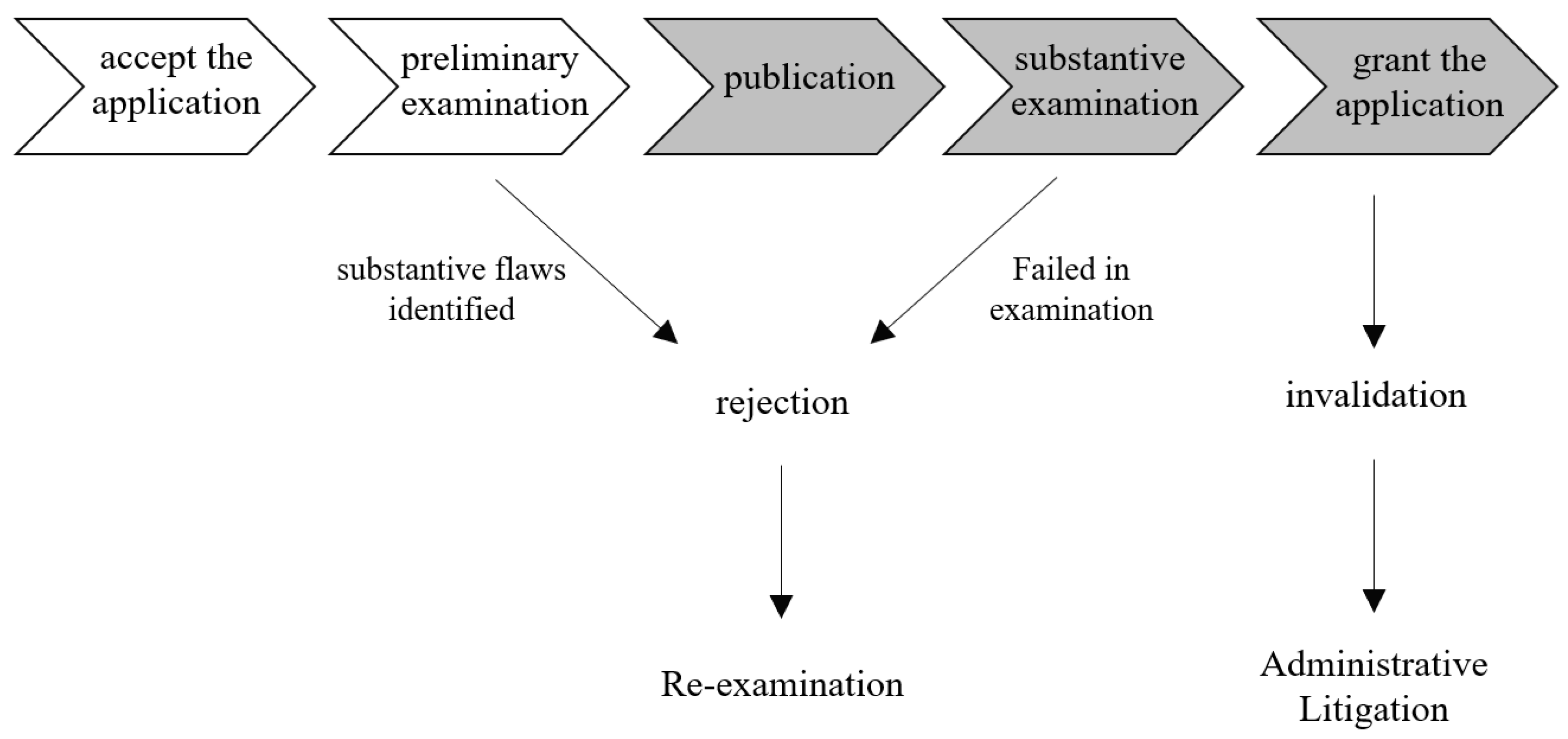
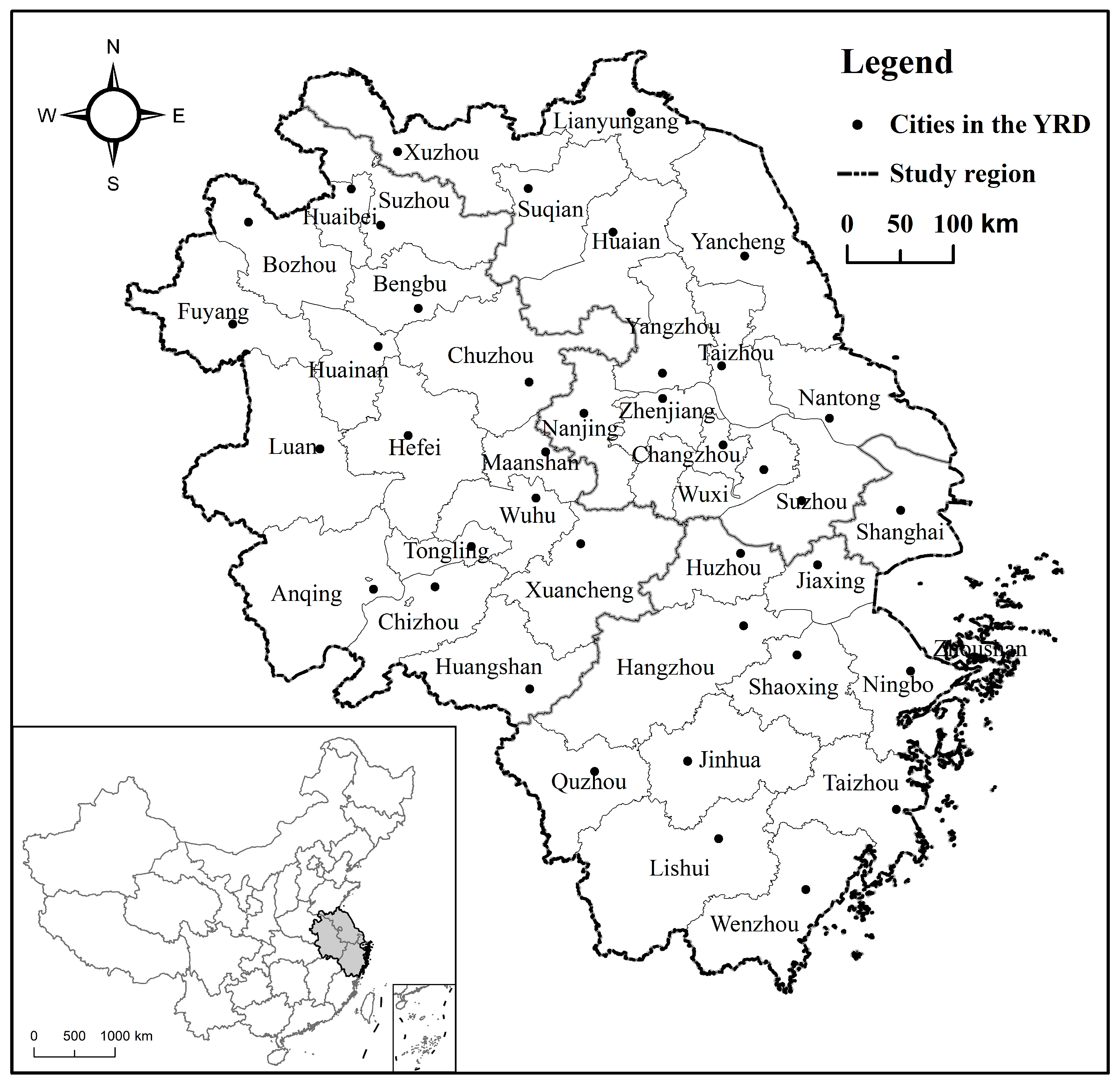

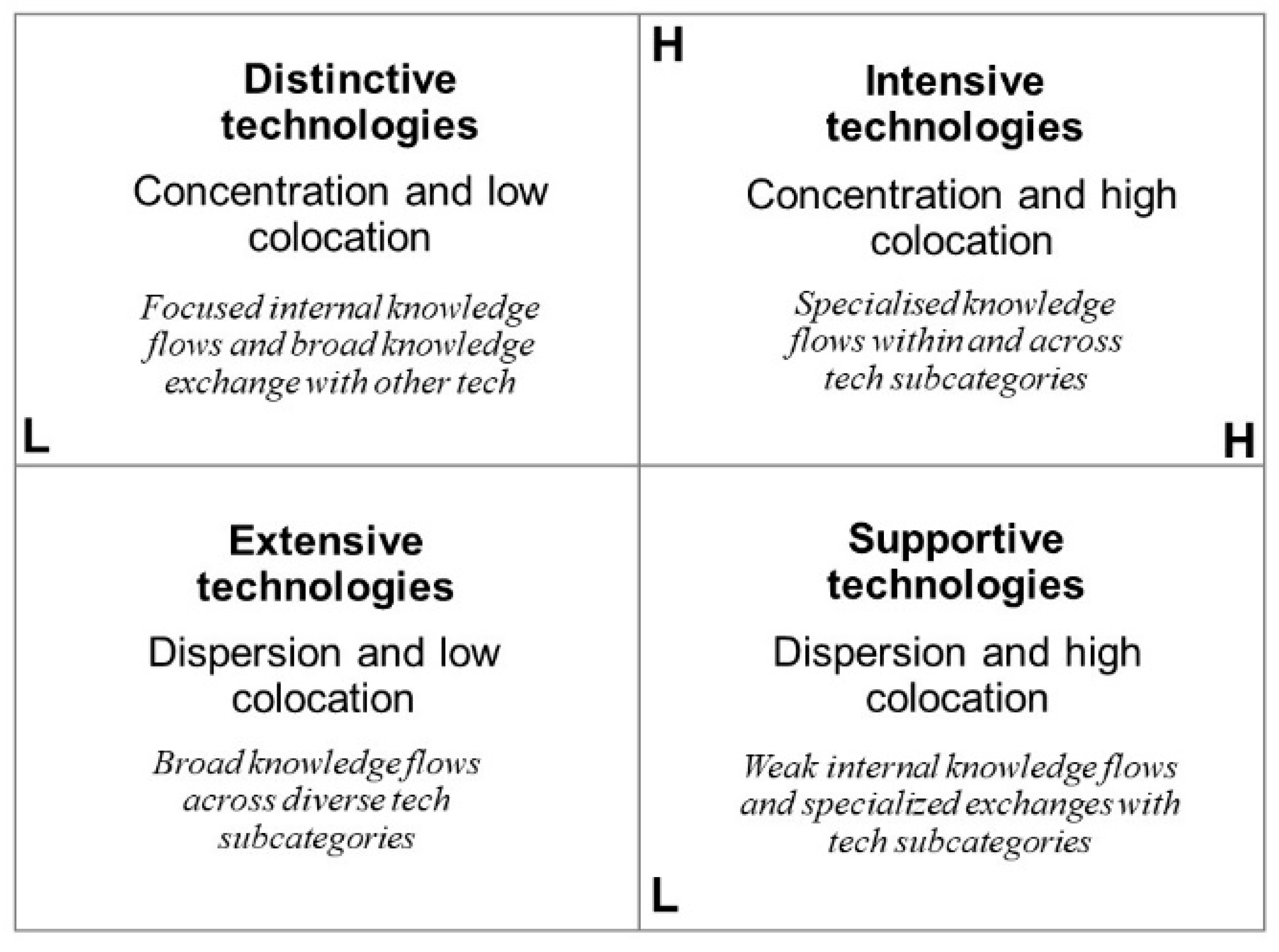
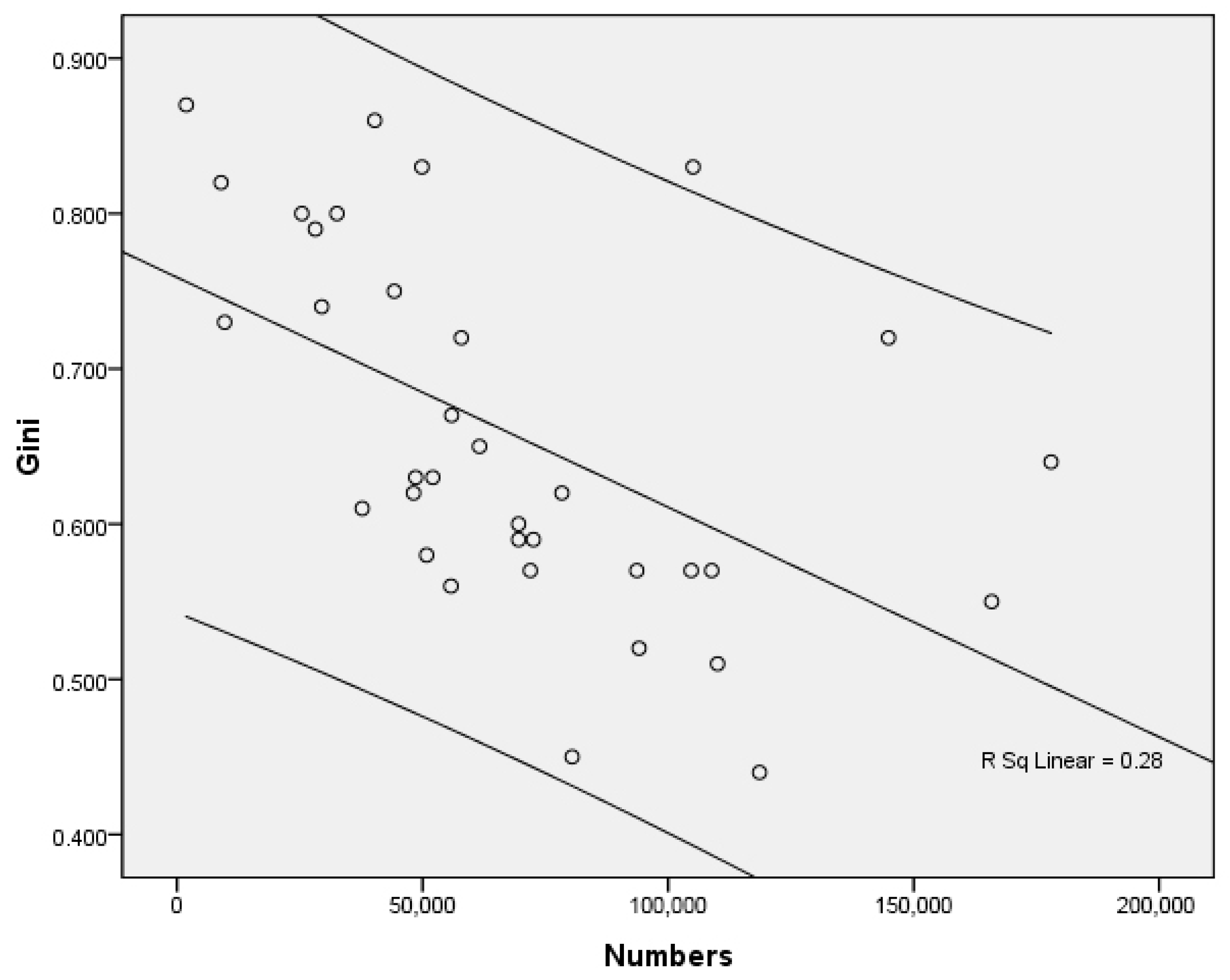


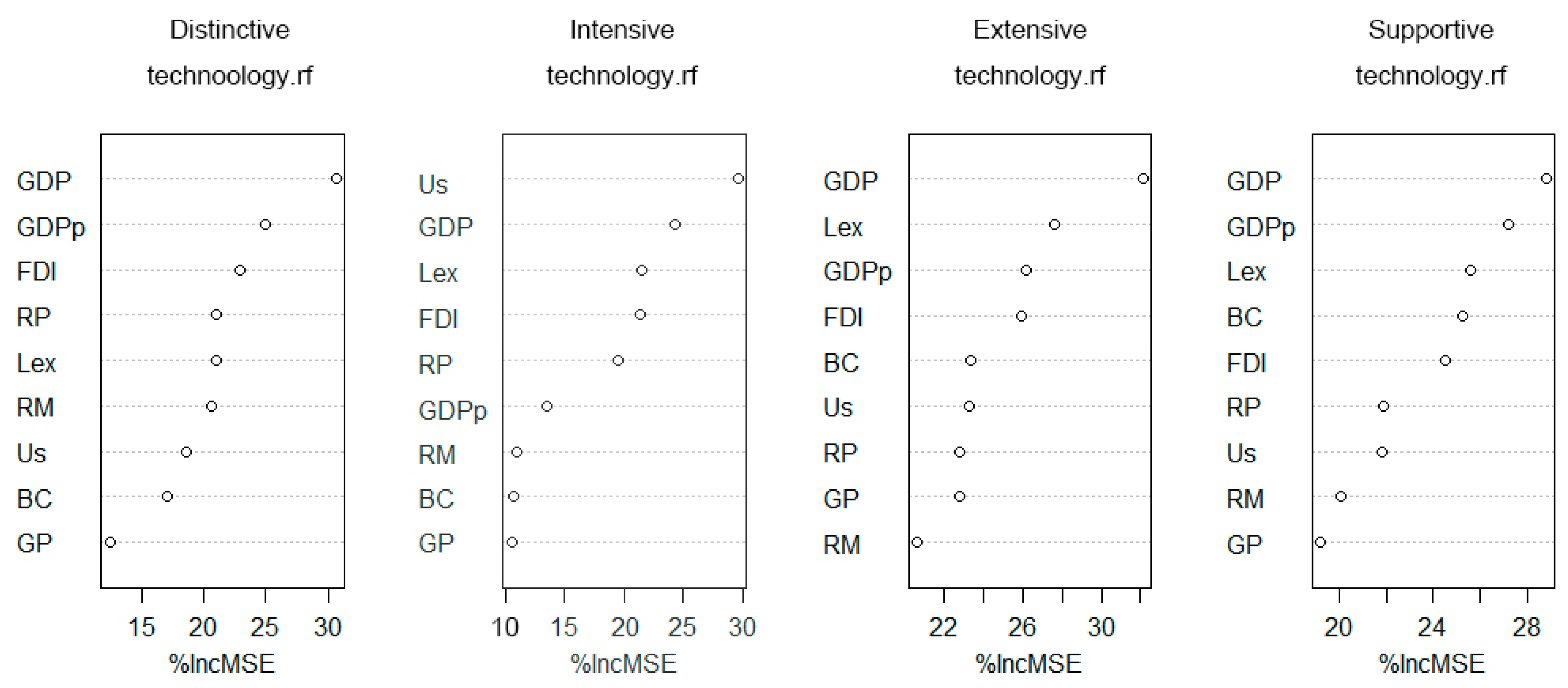
| Description | Min | Max | Median | Mean | SE | ||
|---|---|---|---|---|---|---|---|
| Dependent variables—four classifications of technologies | |||||||
| Distinctive technologies | No. of patents | 1 | 8244 | 219 | 790 | 72.44 | |
| Intensive technologies | No. of patents | 2 | 24,805 | 302 | 1579 | 189.43 | |
| Extensive technologies | No. of patents | 15 | 15,897 | 989 | 2211 | 157.60 | |
| Supportive technologies | No. of patents | 4 | 15,386 | 960 | 1939 | 133.50 | |
| Independent variables | |||||||
| Variable 1 | Residential population | 10,000 persons | 72.4 | 2425.68 | 469.07 | 524.50 | 19.62 |
| Variable 2 | GDP | 100 million Yuan | 300.84 | 32,679.87 | 2300.2 | 3765.51 | 236.60 |
| Variable 3 | GDP per capita | Yuan/person | 9528 | 174,270 | 58276.3 | 64,077.79 | 1850.51 |
| Variable 4 | Public expense | 10,000 Yuan | 0.0907 | 8351.54 | 278.71 | 497.49 | 47.06 |
| Variable 5 | Building construction | 10,000 sq.m | 171.56 | 87,557.21 | 4099.3 | 10,942.58 | 773.97 |
| Variable 6 | Green area per capita | Sq.m | 5.79 | 19.7 | 13.39 | 13.29 | 0.14 |
| Variable 7 | Road mileage | km | 1555 | 24306 | 10731 | 10950 | 234.77 |
| Variable 8 | FDI | 100 million USD | 0.3751 | 185.14 | 7.2279 | 15.73 | 1.40 |
| Variable 9 | University students | 10,000 persons | 0.4994 | 85.6796 | 5.61 | 10.73 | 0.83 |
| No. | Technological Field Name | Gini Coeff. | Top Three Cities in Terms of Valid Invention IPC Numbers |
|---|---|---|---|
| 1 | Electrical machinery, apparatus, energy | 0.64 | Shanghai, Suzhou/Jiangsu, Nanjing/Jiangsu |
| 2 | Audio-visual technology | 0.74 | Shanghai, Suzhou/Jiangsu, Hangzhou/Zhejiang |
| 3 | Telecommunications | 0.80 | Shanghai, Nanjing/Jiangsu, Hangzhou/Zhejiang |
| 4 | Digital communication | 0.86 | Shanghai, Hangzhou/Zhejiang, Nanjing/Jiangsu |
| 5 | Basic communication processes | 0.82 | Shanghai, Nanjing/Jiangsu, Suzhou/Jiangsu |
| 6 | Computer technology | 0.83 | Shanghai, Nanjing/Jiangsu, Hangzhou/Zhejiang |
| 7 | IT methods for management | 0.80 | Shanghai, Nanjing/Jiangsu, Hangzhou/Zhejiang |
| 8 | Semiconductors | 0.83 | Shanghai, Suzhou/Jiangsu, Wuhu/Anhui |
| 9 | Optics | 0.79 | Shanghai, Suzhou/Jiangsu, Nanjing/Jiangsu |
| 10 | Measurement | 0.72 | Shanghai, Nanjing/Jiangsu, Hangzhou/Zhejiang |
| 11 | Analysis of biological materials | 0.73 | Shanghai, Nanjing/Jiangsu, Hangzhou/Zhejiang |
| 12 | Control | 0.72 | Shanghai, Nanjing/Jiangsu, Hangzhou/Zhejiang |
| 13 | Medical technology | 0.67 | Shanghai, Suzhou/Jiangsu, Hangzhou/Zhejiang |
| 14 | Organic fine chemistry | 0.65 | Shanghai, Nanjing/Jiangsu, Hangzhou/Zhejiang |
| 15 | Biotechnology | 0.75 | Shanghai, Nanjing/Jiangsu, Hangzhou/Zhejiang |
| 16 | Pharmaceuticals | 0.58 | Nanjing/Jiangsu, Shanghai, Hangzhou/Zhejiang |
| 17 | Macromolecular chemistry, polymers | 0.59 | Shanghai, Suzhou/Jiangsu, Hefei/Anhui |
| 18 | Food chemistry | 0.45 | Hefei/Anhui, Wuhu/Anhui, Nanjing/Jiangsu |
| 19 | Basic materials chemistry | 0.52 | Shanghai, Suzhou/Jiangsu, Nanjing/Jiangsu |
| 20 | Materials, metallurgy | 0.57 | Shanghai, Suzhou/Jiangsu, Nanjing/Jiangsu |
| 21 | Surface technology, coating | 0.63 | Wuxi/Jiangsu, Suzhou/Jiangsu, Shanghai |
| 22 | Micro-structure and nano-technology | 0.87 | Shanghai, Suzhou/Jiangsu, Wuxi/Jiangsu |
| 23 | Chemical engineering | 0.51 | Suzhou/Jiangsu, Shanghai, Nanjing/Jiangsu |
| 24 | Environmental technology | 0.59 | Shanghai, Nanjing/Jiangsu, Suzhou/Jiangsu |
| 25 | Handling | 0.57 | Suzhou/Jiangsu, Shanghai, Wuxi/Jiangsu |
| 26 | Machine tools | 0.55 | Suzhou/Jiangsu, Shanghai, Wuxi/Jiangsu |
| 27 | Engines, pumps, turbines | 0.61 | Shanghai, Hangzhou/Zhejiang, Suzhou/Jiangsu |
| 28 | Textile and paper machines | 0.60 | Suzhou/Jiangsu, Shanghai, Wuxi/Jiangsu |
| 29 | Other special machines | 0.44 | Suzhou/Jiangsu, Shanghai, Nanjing/Jiangsu |
| 30 | Thermal processes and apparatus | 0.62 | Shanghai, Suzhou/Jiangsu, Ningbo/Zhejiang |
| 31 | Mechanical elements | 0.57 | Suzhou/Jiangsu, Shanghai, Wuxi/Jiangsu |
| 32 | Transport | 0.62 | Shanghai, Suzhou/Jiangsu, Wuhu/Anhui |
| 33 | Furniture, games | 0.56 | Suzhou/Jiangsu, Ningbo/Zhejiang, Shanghai |
| 34 | Other consumer goods | 0.63 | Wuxi/Jiangsu, Hefei/Anhui Suzhou/Jiangsu |
| 35 | Civil engineering | 0.57 | Shanghai, Suzhou/Jiangsu, Nanjing/Jiangsu |
| Fields | Computer, Communication, Biochemistry | Mechanic, Gadget, Chemical Engineering | Foods |
|---|---|---|---|
| Computer technology | 0.932 | ||
| IT methods for management | 0.912 | ||
| Telecommunications | 0.912 | ||
| Digital communication | 0.908 | ||
| Biotechnology | 0.894 | ||
| Organic fine chemistry | 0.880 | ||
| Basic communication processes | 0.875 | ||
| Micro-structure and nano-technology | 0.875 | ||
| Analysis of biological materials | 0.868 | ||
| Measurement | 0.846 | ||
| Semiconductors | 0.844 | ||
| Control | 0.843 | ||
| Pharmaceuticals | 0.795 | 0.416 | |
| Civil engineering | 0.79 | 0.549 | |
| Medical technology | 0.789 | 0.592 | |
| Engines, pumps, turbines | 0.769 | 0.55 | |
| Optics | 0.746 | 0.612 | |
| Environmental technology | 0.635 | ||
| Materials, metallurgy | 0.636 | ||
| Transport | 0.623 | ||
| Audio-visual technology | 0.708 | ||
| Electrical machinery, apparatus, energy | 0.727 | ||
| Macromolecular chemistry, polymers | 0.698 | ||
| Basic materials chemistry | 0.641 | 0.382 | |
| Chemical engineering | 0.786 | ||
| Thermal processes and apparatus | 0.747 | ||
| Mechanical elements | 0.842 | ||
| Other special machines | 0.806 | 0.355 | |
| Surface technology, coating | 0.854 | ||
| Handling | 0.9 | ||
| Textile and paper machines | 0.899 | ||
| Machine tools | 0.937 | ||
| Food chemistry | 0.882 | ||
| Furniture, games | 0.881 | ||
| Other consumer goods | 0.71 | ||
| Variance explained | 48.37% | 38.07% | 6.18% |
| Fixed Effects Model (Coefficient) | Random Forest Relative Importance (%IncMSE) | |||||||
|---|---|---|---|---|---|---|---|---|
| Model 1 | Model 2 | Model 3 | Model 4 | Model 5 | Model 6 | Model 7 | Model 8 | |
| Distinctive Technology | Intensive Technology | Extensive Technology | Supportive Technology | Distinctive Technology | Intensive Technology | Extensive Technology | Supportive Technology | |
| Residential population (RP) | 0.126 | −0.154 | 0.384 | 0.516 | 21.034 | 19.837 | 23.619 | 21.917 |
| GDP (GDP) | 1.779 *** | 1.931 *** | 1.705 *** | 1.387 *** | 30.631 | 24.260 | 31.814 | 28.772 |
| GDP per capita (GDPp) | 0.025 | −0.168 *** | 0.217 ** | 0.271 ** | 24.900 | 13.442 | 27.683 | 27.177 |
| Public expense (Lex) | −0.520 *** | −0.589 *** | −0.680** | −0.649 ** | 20.976 | 21.413 | 26.962 | 25.556 |
| Building construction (BC) | −0.027 | −0.033 | −0.018 | −0.034 | 17.012 | 10.689 | 24.048 | 25.252 |
| Green area per capita (GP) | −0.043 * | −0.044 ** | 0.004 | 0.053 | 12.513 | 10.392 | 19.481 | 19.218 |
| Road mileage (RM) | 0.024 | 0.012 | 0.092 | 0.093 | 20.662 | 10.858 | 21.742 | 20.108 |
| Actual utilized FDI (FDI) | 0.331 *** | 0.290 *** | 0.595 *** | 0.514 *** | 22.864 | 21.315 | 25.099 | 24.503 |
| University student (Us) | 0.670 *** | 0.311 ** | 0.816 *** | 0.751 ** | 18.618 | 29.528 | 22.127 | 21.821 |
| R square | 0.962 | 0.971 | 0.936 | 0.885 | ||||
| % Var explained | 0.937 | 0.958 | 0.913 | 0.860 | ||||
Disclaimer/Publisher’s Note: The statements, opinions and data contained in all publications are solely those of the individual author(s) and contributor(s) and not of MDPI and/or the editor(s). MDPI and/or the editor(s) disclaim responsibility for any injury to people or property resulting from any ideas, methods, instructions or products referred to in the content. |
© 2024 by the authors. Licensee MDPI, Basel, Switzerland. This article is an open access article distributed under the terms and conditions of the Creative Commons Attribution (CC BY) license (https://creativecommons.org/licenses/by/4.0/).
Share and Cite
Li, L.; Wang, L.; Zhang, X.; Wang, L. Technological Composition and Innovation Factors in Inventive Yangtze River Delta: Evidence from Patent Inventions. Appl. Sci. 2024, 14, 1842. https://doi.org/10.3390/app14051842
Li L, Wang L, Zhang X, Wang L. Technological Composition and Innovation Factors in Inventive Yangtze River Delta: Evidence from Patent Inventions. Applied Sciences. 2024; 14(5):1842. https://doi.org/10.3390/app14051842
Chicago/Turabian StyleLi, Lingyue, Lie Wang, Xiaohu Zhang, and Lan Wang. 2024. "Technological Composition and Innovation Factors in Inventive Yangtze River Delta: Evidence from Patent Inventions" Applied Sciences 14, no. 5: 1842. https://doi.org/10.3390/app14051842
APA StyleLi, L., Wang, L., Zhang, X., & Wang, L. (2024). Technological Composition and Innovation Factors in Inventive Yangtze River Delta: Evidence from Patent Inventions. Applied Sciences, 14(5), 1842. https://doi.org/10.3390/app14051842







